About the Nottawasaga
River Restoration Program
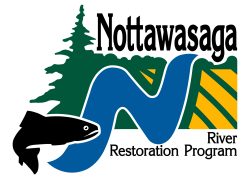
The Nottawasaga River Restoration Program (NRRP) is a stream restoration initiative coordinated by NVCA and Nottawasaga Futures – South Simcoe Streams Network. The NRRP started in 2018 and is going into its 6th year of operation in 2024. The program aims to improve water quality in the Upper Nottawasaga River and its Sheldon Creek tributary in order to enhance the world class trout and salmon sport fishery and restore native fish habitat.
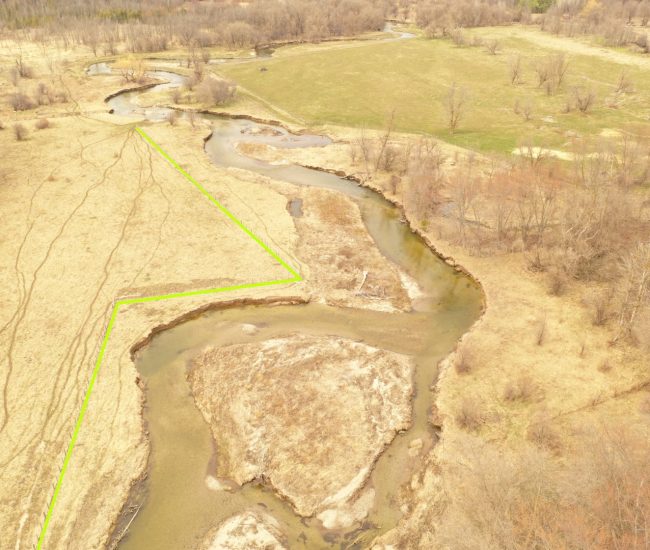
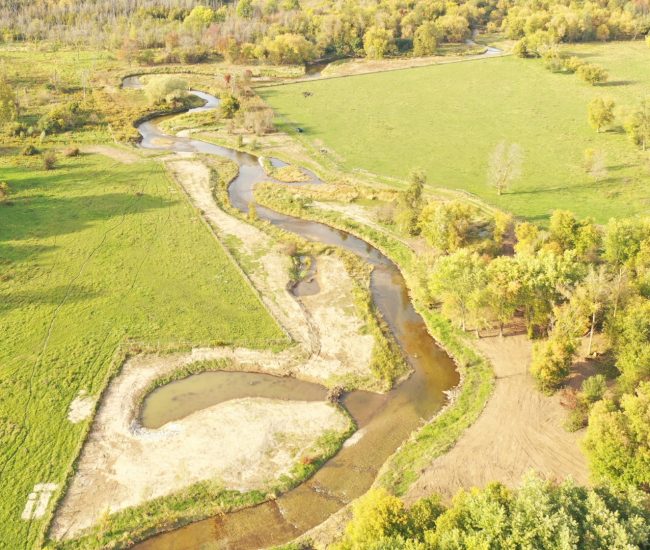
In this photo: Before (left) and After Habitat Restoration (right) of the Nottawasaga River
The goal of the NRRP is to extend the high-quality water and coldwater trout habitat currently in the Village of Hockley downstream to the Nottawasaga River’s confluence with Innisfil Creek south-east of Alliston. To achieve this, NVCA is working with partners, funders and volunteers to restore 10 km of degraded stream habitat within a target reach on the main river and its Sheldon Creek tributary.
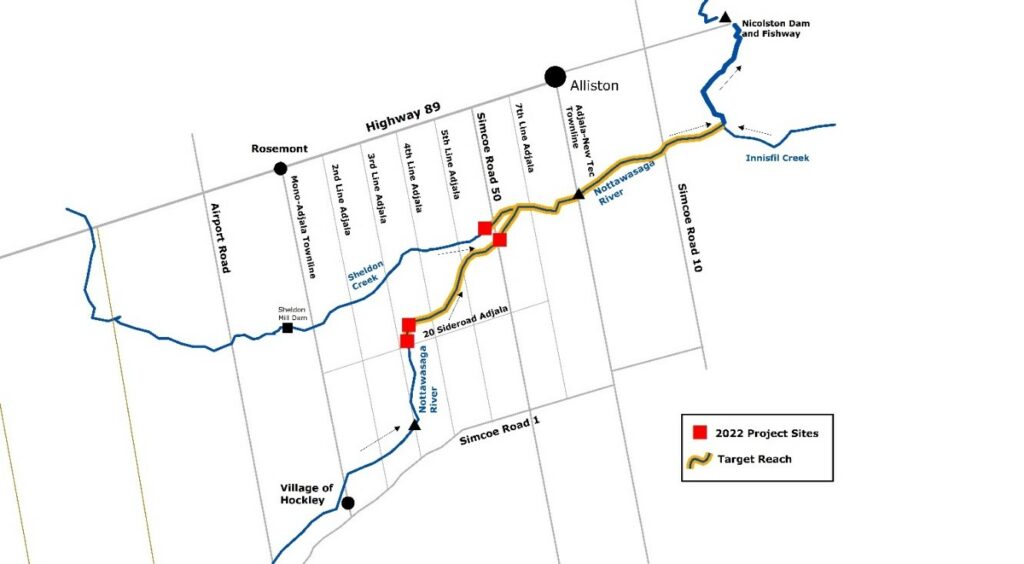
The NRRP provides benefits for flood and erosion control as well as optimizing improvements to fish habitat, floodplain wetlands and water quality. Engaging a wide range of volunteers, landowners, community groups and local municipalities is a guiding principle of the NRRP. Check out the four-step process that is used for river restoration projects.
About the Nottawasaga River
The Nottawasaga River flows through significant environmental features such as the Niagara Escarpment World Biosphere Reserve and the internationally recognized Minesing Wetlands.
The world class environmental landforms which straddle the river and its proximity to the biggest urban area in Canada make it a large recreational resource for the people of Ontario, while also providing a critical source of clean water for local communities. It is the largest tributary of Georgian Bay, draining farmland south of the Canadian Shield.
The Nottawasaga River supports sport fisheries which provide important economic benefits for many local municipalities. For example, summer Chinook salmon fishing in Georgian Bay is extremely popular in the Town of Collingwood and Town of Wasaga Beach. In the fall, many anglers fish for Chinook salmon and rainbow trout in the Nottawasaga River in the Township of Essa.
The river is also home to native species such as brook trout and river burbot, as well as two species at risk – lake sturgeon and northern brook lamprey.
All of these fish rely on healthy waterways to thrive.
What progress have we made so far?
Between 2019 and 2021, 1.2 km of river habitat was rehabilitated, including bank stabilization, woody trout cover habitat installation, spawning channel creation and 3,600 riverside trees planted. Check it out here!
In 2022, an additional 800 m of eroding river bank was stabilized and improved with woody trout cover habitat bringing the total up to 2km of river restored towards the 10 km goal. Other 2022 achievements included planting 1,700 trees and installing 750 m of fencing designed to keep livestock out of the creek. Check out the progress and 2024 work plans!
Learn more about our restoration efforts by selecting a watercourse below
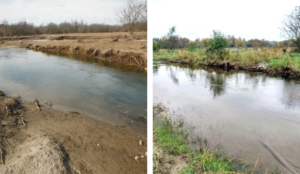
In this photo: Before (left) and After Habitat Restoration (right) of the Upper Nottawasaga River
Restoration efforts begin in the Upper Nottawasaga River, downstream from the Village of Hockley where excellent water quality from the Niagara Escarpment deteriorates quickly. This is caused by soil and nutrients released from eroding river banks and surrounding lands. Summer stream temperatures also rise quickly as there is a limited amount of forest cover providing shade to the river.
Together, all of these factors degrade the habitat for sports fisheries in the Nottawasaga River.
NVCA’s stewardship team and volunteers planted native trees and shrubs along the river, stabilized eroding streambanks, constructed woody instream cover habitats, re-created floodplain habitats, enhanced wetlands and worked with a local landowner to install livestock exclusion fencing.
The first project started under the NRRP involved the construction of fencing to exclude cattle from the upper Nottawasaga River. Between 2019 and 2022, we completed 900m of river habitat restoration at this inaugural property, representing the largest project of its type completed by the NVCA and one of the largest in southern Ontario. Starting in 2022, we began working on a new property immediately downstream and we are looking to develop partnerships with other landowners in the section of the Upper Nottawasaga River between the Village of Hockley and the 3rd Line of Adjala-Tosorontio!
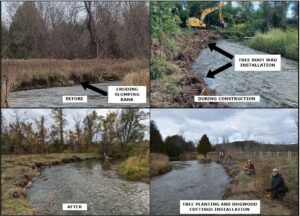
In this photo: Before, during, and after restoration on a private property east of Airport Rd on the Pine River
To improve water quality and fish habitat in the Nottawasaga River, it is important to restore the tributary streams that flow into the main river. To achieve this, NVCA developed a trout habitat restoration plan for the Pine River and implemented a stream restoration pilot project in 2022 for the new Pine River Enhancement Program.
Using scientific data , NVCA identified that the excellent water quality in the Pine River starts to decline at Airport Road in the Township of Mulmur. In 2022, staff and volunteers stabilized 150m of eroding streambank and installed trout cover habitats along the Pine River.
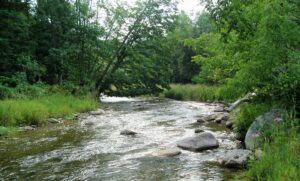
NVCA is working with the Friends of the Mad River through NRRP to coordinate the Mad River Enhancement Program (MREP).
In 2022, stream temperature, river morphology and fish community data were collected to help develop a river restoration plan. Using this information, NVCA’s stewardship staff identified a high priority restoration area on the Mad River between Creemore and Glencairn. Additional data will be collected in 2023.
A pilot river restoration project will also take place in 2023 at Carruthers Park near Airport Road.
The Friends of the Mad River are raising funds to complete the restoration plan and to support future river work on the Mad River. If you are interested in donating, please visit NVCA’s Canada Helps page and choose “Mad River Enhancement” from the drop down menu.
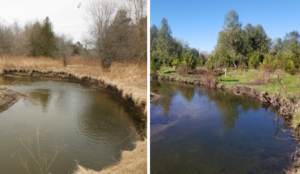
In this photo: Before (left) and After Habitat Restoration (right) of Sheldon Creek
Sheldon Creek is one of the coldest, cleanest, and healthiest streams in the Nottawasaga Watershed. As it flows out of the Niagara Escarpment, the stream supports high quality coldwater fish habitat and provides excellent spawning habitat for trout and salmon.
Through scientific data, NVCA discovered that there is a shift towards more tolerant species at the lower sections of Sheldon Creek that enter the Nottawasaga River. This tells us that the water quality and trout habitat are slowly degrading as the water leaves the escarpment and flows into Adjala-Tosorontio. Summer stream temperatures are seen to increase as the water moves downstream at 4th Line in Adjala-Tosorontio due to a lack of stream-side forest cover. The concentration of phosphorus in the water also increases due to nutrient rich soil and manure runoff into the river.
Step one of the restoration process is to reduce the phosphorus levels that go in the water.
Over 700m of livestock fencing was installed on both sides of the riverbank so that cattle would not trample the vegetation along the river. This reduces erosion and enhances stream habitat. Volunteers helped to plant trees and heavy machinery installed natural vegetation onto the slopes as well as woody habitat for fish and wildlife.
NVCA’s river restoration staff are looking forward to completing this project in 2025 by restoring 1.4km of Sheldon Creek.
Black Ash Creek
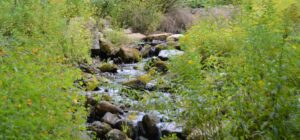
Located in the headwaters of Black Ash Creek in the Town of the Blue Mountains, the Petun Dam was a six-metre high man-made earthen structure that created a 100m long stagnant pond. The pond supported algae growth and increased summer stream temperatures by 7oC!
In 2020, NVCA completed a $160,000 project to remove the dam and restore 130m of stream habitat on Black Ash Creek in the Town of the Blue Mountains. This project improved downstream water temperatures and water quality, enhanced brook and rainbow trout habitat, removed a potential threat for downstream flooding, and addressed future impacts from climate change.
In 2021, volunteers and NVCA staff planted native trees, grasses and shrubs throughout the site, increasing biodiversity.
The dam removal is the largest ecological restoration project that NVCA has completed in the Town of the Blue Mountains and this work will provide water quality benefits further downstream in the Township of Clearview and Town of Collingwood.
This project was made possible through the generous funding from Bruce Power, Greenbelt Foundation and a wide range of other partners.
How can you help?
Land owners
Do you have a section of the Nottawasaga River, Mad River, Pine River or Sheldon Creek that is degraded? You may qualify to participate in the Nottawasaga River Restoration Program.
Donations
Since 2019, we have restored 2km of the Nottawasaga River and Sheldon Creek but we have 8km left to go. We are looking to pick up the pace of restoration efforts. That’s why we are raising funds that will go towards purchasing materials, equipment and staffing costs. We welcome:
- Monthly gifts
- Single gifts
- Corporate giving
- Financial support from grants and foundations
Volunteer with us!
Starting in the Spring and all the way to the Fall, NVCA recruits volunteers for river restoration work days. Restoration work includes tree planting and in-water bank stabilization.
More information can be found on NVCA’s website, by subscribing to our monthly newsletter, or by contacting:
If you have any questions about the NRRP, are interested in completing a stream rehabilitation project, or would like to make a donation to support river restoration within the NVCA area of jurisdiction, please contact Fred Dobbs, Manager of Stewardship Services at fdobbs@nvca.on.ca
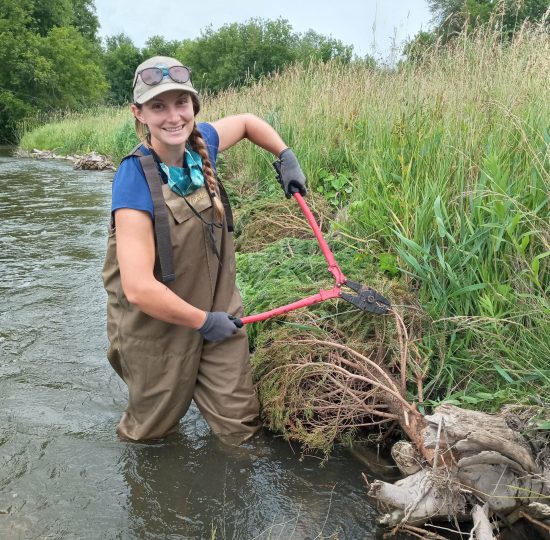
![]() Who to Contact
Who to Contact
![]() Sarah Campbell
Sarah Campbell![]() 705-424-1479 x 243
705-424-1479 x 243![]() scampbell@nvca.on.ca
scampbell@nvca.on.ca
![]() Laura Wensink
Laura Wensink![]() 705-424-1479 x 275
705-424-1479 x 275![]() lwensink@nvca.on.ca
lwensink@nvca.on.ca